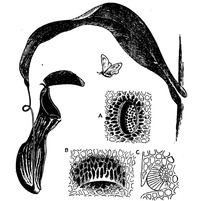

Pitcher Plant
N. rajah was first collected by Hugh Low on Mount Kinabalu in 1858, and described the following year by Joseph Dalton Hooker, who named it after James Brooke, the first White Rajah of Sarawak. Hooker called it one of the most striking vegetable productions hither-to discovered. Since being introduced into cultivation in 1881, Nepenthes rajah has always been a much sought-after species. For a long time, the plant was seldom seen in private collections due to its rarity, price, and specialised growing requirements. However, recent advances in tissue culture technology have resulted in prices falling dramatically, and N. rajah is now relatively widespread in cultivation.Furthermore, some pitcher plants contain mutualistic insect larvae, which feed on trapped prey, and whose excreta the plant absorbs. Whatever the mechanism of digestion, the prey items are converted into a solution of amino acids, peptides, phosphates, ammonium and urea, from which the plant obtains its mineral nutrition (particularly nitrogen and phosphorus). Like all carnivorous plants, they occur in locations where the soil is too poor in minerals and/or too acidic for most plants to be able to grow. More
* Pitcher of pitcher plant is made of? * Where does a pitcher Plant live? * Were do you find pitcher plants? * How can you get the pitcher plant? » More Follow usFacebook Facebook Twitter Twitter YouTube YouTube Mentioned in * sarracenia * ascidium (botany) * insectivorous * huntsman More
* Sarraceniaceae - This family of pitcher plants grow in the New World and can be broken down into three genera (groups of species): * Sarracenia - All of these species grow in North America. More
